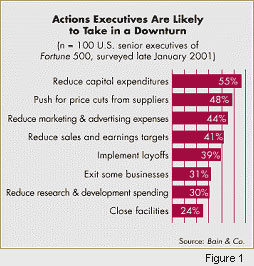By Mark Usher and David Tunney
“Before making any announcements, executives should reflect on the last time they cut back during a slowdown. They downsized, but so did their competition; they lowered costs, and the competition followed; they lowered prices, and the competition matched. When the dust cleared, their company survived but was smaller, weaker, demoralized, and still without a competitive advantage.” – The Wall Street Journal – April 23, 2001
During these uncertain times, companies are seeking ways to dramatically reduce costs through a series of standard actions as reflected in the adjacent survey results of Fortune 500 executives (Figure 1). While the need for realizing ROI is paramount, such cost reduction efforts should be balanced with longer-term strategic objectives. Without clear goals and a strategic plan to improve operations and invest in innovation, companies may weaken their competitive position by only taking the predictable actions that only address near term capital concerns — ones that their competitors are also likely to take. Since growth is driven by innovation and margins are driven by operational excellence, cost cutting actions alone are often not sufficient to truly gain a competitive advantage when the economy turns around. Our strategy for taking advantage of the downturn involves four critical steps that exploit the downturn as an opportunity to cut costs, improve operational agility, and competitive positioning.

Step 1. Capture quick hit savings from rapid returns initiatives.
There are several areas where companies can capture hard, measurable benefits from initiatives such as procurement, inventory reduction, transportation mode optimization and streamlining of warehouse operations. Many companies today drive for price reductions from their direct suppliers in their procurement initiatives. We believe there are great opportunities for quick hit savings within indirect procurement purchases of goods and services which support internal operations such as office supplies, IT hardware, telecom and travel. These expenditures typically comprise 15%-35% of a company’s revenues, and yet purchase decisions associated with them are often made without the same rigor and control that is generally applied to those direct purchases which are part of a company’s cost of sales. Through techniques such as volume aggregation, supplier negotiation and re-contracting, a company currently spending $500M annually on indirect materials, can accumulate and book cost savings of as much as $5M over a six month period.
Step 2. Remediation of existing technology.
Many organizations have made significant investments in technology systems that have yet to demonstrate the promised return on investment. In a recent NAPM/Forrester survey of 407 companies, only 26% reported cost savings from Internet-based purchasing activities. An example of this is Nike, where the CEO Roger Knight recently complained that he had yet to see any return on his company’s multi-million dollar investment in its supply chain planning software application. According to The Gartner Group and Forrester Research substantially more organizations have been disappointed with the results from their various technology investments to date than those who feel they have realized the promised value.
Most often the reason for technology not meeting expectations is not the technical performance of the tool itself, but rather an unsuccessful process of driving adoption and compliance among senior internal stakeholders, the users and supplier communities. Companies who recognize that these “sunk” technology investments represent another source of funds and initiate programs to release these funds will be among the best positioned financially and operationally when the economic upturn begins. We call this activity technology remediation.
Those who remediate their B2B systems through actions such as strategic sourcing, technical integration improvements, user adoption strategies, training strategies, and building business cases for key supplier adoption will lead the pack by realizing and surpassing earlier ROI expectations. They will not only generate stronger cash flow, but will also enter the upturn with their enabling infrastructure optimized to capture a larger, sustainable benefit stream that has a direct impact on earnings per share.
Step 3. Protect Existing Margins.
Direct captured funds, which were generated from ROI-focused initiatives, toward key projects that will drive greater operational efficiency. This will enable your company to increase shareholder value without requiring additional revenue through sales in a down market. Favorable profit performance in a tight market can then have the secondary effect of releasing additional capital for investment to drive further strategic growth.
Consider for example how GE has addressed the issue of investing strategically in targeted technology enablers to protect its margins. GE expects to squeeze between $1 billion and $1.5 billion from its operating margin, or 10 cents per share in 2001, from digitization alone. Simply cutting costs through staff reductions does not guarantee long-term productivity. However, making sure the task itself is performed most efficiently does. Instead of simply changing the number of people it takes to do a job through layoffs, GE is changing how these jobs are done – resulting in GE’s ability to protect margins and increasing the percentage of revenue per employee. Fewer employees will be required for the same-or greater-output, therefore giving GE sustainable margin protection and competitive positioning. Most companies have the technology in place to accomplish a similar feat, yet have not exploited the capabilities offered by making the necessary process and people changes such as GE. 1
Step 4. Invest in Innovation
Reinvesting captured funds into innovative strategic investments is necessary to leapfrog competition — especially since many companies are currently delaying the development of bleeding-edge capabilities in the current downturn. Take note that innovation does not necessarily require an immediate, large and risky capital investment in technology that is still evolving and has yet to deliver the full capabilities of its promise. Invest wisely — the real key to successful future innovation is collaboration. While ERP, supply chain, and B2B systems provide the technical infrastructure for global integration within and between companies, it will take more than just a technology tool to extend the collaboration efforts beyond an organization’s four walls.
Although Internet-enabled collaborative commerce between companies and their suppliers is still in its infancy, it will be central to commerce in the not too distant future. To prepare for this trend, companies should focus on the development of their internal collaboration capabilities such as building cooperation and streamlining processes between sales, research and development, planning and manufacturing. This capability will create the necessary foundation to enable an organization to successfully participate in collaborative commerce, which is evolving towards complex, extended enterprise communities that link together, multiple value chains. Technology will be a critical enabler, but if your senior management can’t drive collaboration between your current organizations for continually improving operational efficiency, how can your enterprise effectively negotiate, execute and sustain an extended set of relationships as a value added partner in collaborative commerce?
Executive leadership should act now by focusing on creating a collaborative organization that embodies the characteristics essential for successfully leveraging the next generation business-to-business practices and technology. A research study (Figure 4) has shown that companies that are flexible, empowering, and collaborative are performing and will perform better in the use of Internet technology than their competitors. The pacesetters and laggards in this study describe no differences in how hard they work, but are very different in how collaboratively they work. 2
Laying this sound operational and organizational foundation ahead of future multi-enterprise technology investments will allow companies to take full advantage of the future of Internet commerce while improving operations, profitability and competitive positioning along the way.
Conclusion.
Missed sales projections, a volatile stock market, massive layoffs, businesses closing down — although we have seen this turbulent stage of the business cycle before, many companies are struggling just for survival, let alone competitive positioning. However, even with the severe challenges of economic instability, downturns can provide companies with real opportunities for establishing a competitive advantage. Typical company responses to a down market only focus on short-term results and cut investments to build future capabilities. We believe companies who can buck this trend by leveraging the benefit streams of rapid returns and remediation into improving internal collaboration across their supply chain will benefit from both increased operational efficiency and stronger innovation capabilities. This strategy also allows for improved margins in the downmarket and better competitive positioning for leapfrogging more short-sighted competitors as collaborative commerce matures and collaboration becomes THE competitive differentiator. This strategy is the key to being positioned to take advantage of the next generation of eBusiness enabled growth while defending and extending current market boundaries.
1 “While Welch Waited,” The Economist, March 19, 2001
2 Kanter, Rosabeth, Evolve! Succeeding in the Digital Culture of Tomorrow, Harvard Business School Press, Boston, MA, 2001.

Mark Usher is Director, Value Creation Solutions at The Genesis Group. Prior to joining Genesis, Mark was a senior manager at Accenture. He has fifteen years of industry and management consulting experience. He has expertise across the supply chain and has identified and delivered significant savings to clients through strategic sourcing, eProcurement reengineering, organization design, and B2B eMarket strategies.

David Tunney is Director, Transition Management Solutions at The Genesis Group. David joined Genesis from PricewaterhouseCoopers. He has fifteen years of business and consulting experience. His expertise provides his clients with transition strategy, management and executive coaching associated with changing business models, technologies, processes, people, organization and management practices.
The Genesis Group provides business operations strategy, value chain optimization and transition management consulting solutions. The company has offices in Seattle, Oregon and California.
The Genesis Group
20607 208th Ave. SE
Seattle, WA 98058
Phone: 425.413.7890
http://www.genesisconsults.com




















